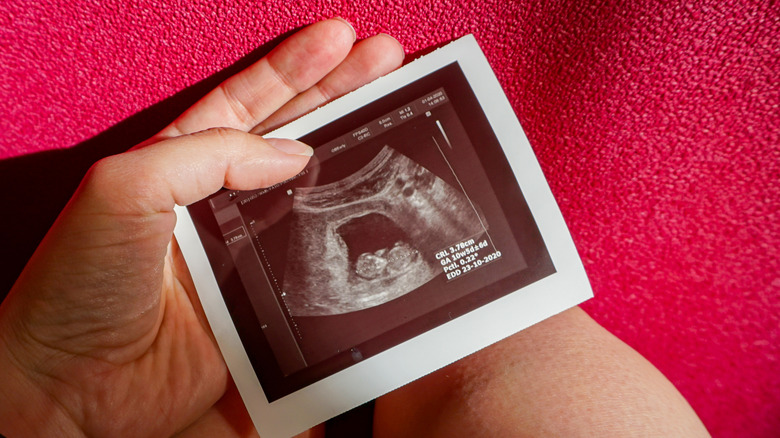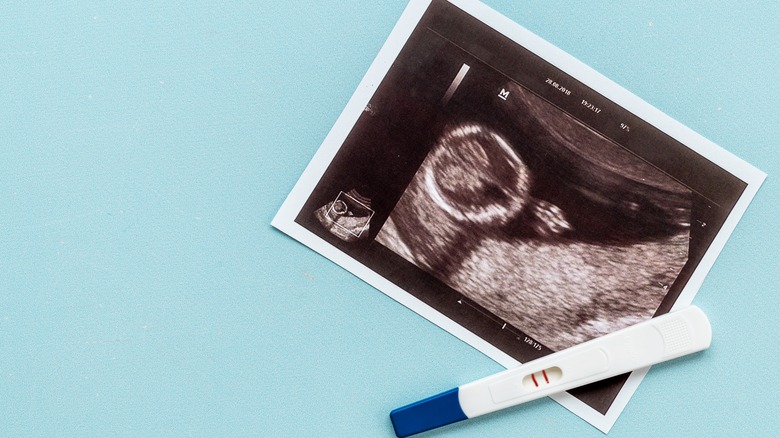The Guardian Is In Hot Water For Publishing Inaccurate Photos Of Abortion
Trigger warning: The following article contains language about miscarriage and pregnancy loss.
When you hear the word "baby," a clear picture probably forms in your head. But what about "fetus?" Politicians and activists on both sides of the abortion issue have been trying to define what a fetus looks like for decades, and with new abortion bans going into effect, a fresh wave of alleged information is coming out about abortions and fetuses.
Before 1840, the United States followed the United Kingdom's "quickening doctrine" when it came to abortions, per the Organization of American Historians (OAH). Abortion was legally acceptable until the pregnant person actually felt the fetus move — something that happens between four and six months. But by the mid-19th century, physicians wanted to establish themselves as more trained and more professional than their healer colleagues. They pushed for licensing and government regulations, forcing the competition out of the market. According to the OAH, by 1900 abortions were banned in every state, though doctors were able to perform abortions "at their own discretion."
Since then abortion has been an issue that drives people to the polls, but the arguments on both sides can be based on emotion over fact. As Mother Jones points out, the anti-abortion movement has pushed disinformation, which sometimes has even led to acts of violence. But in an effort to back up to fight against anti-abortion propaganda, The Guardian has published what they claim are actual pictures of what early-term abortion looks like. But some experts are raising concerns, arguing that these photos are missing key details.
The Guardian's abortion pictures were missing these key things
With renewed calls from "murder charges for people who defy abortion bans," it may be more important than ever to understand the facts of abortion: what it is — and what it looks like — from a medical and scientific perspective. This was the motivation behind the MYA Network's documenting the reality of what pregnancies in the first trimester.
Dr. Joan Fleischman, part of the network, told The Guardian that many of her patients have no idea what aborted pregnancy tissue looks like. "That's when I realized how much the imagery on the internet and on placards — showing human-like qualities at this early stage of development — has really permeated the culture."
Dr. Flemishman is referring to a long history of the anti-abortion movement using doctored visuals of fetuses during an abortion. In "Fetal Images: The Power of Visual Culture in the Politics of Reproduction," Rosalind Pollack Petchesky brings up the brutal history of the 1979 anti-abortion propaganda film, "The Silent Scream." For her, the most "disturbing" thing about the way "The Silent Scream" went unquestioned by society. "The curled-up profile," Pollack Petchesky describes, "with its enlarged head and fin-like arms, suspended in its balloon of amniotic fluid, is now so familiar not even most feminists question its authenticity."
According to one OB-GYN, though, the photos supplied to The Guardian were missing the embryo, seemingly trying to manipulate the public perspective of what abortion looks like.
What a fetus actually looks like at nine weeks
Christina Francis, an OB-GYN, spoke with the right-wing news organization the Daily Caller after The Guardian's piece on first-trimester abortions was published. According to her, "Each of the images in the article shows a gestational sac but clearly, the embryonic and fetal human beings have been removed from the images."
Describing the procedure as "a few minutes longer than a Pap test," Dr. Joan Fleischman says that what the pictures in The Guardian shows are accurate representations of the tissue removed during an abortion. Often, she's found when her patients are presented with all of the facts of the procedure, they're relieved.
So what's the truth? According to Planned Parenthood, between week 5 and week 10 of a pregnancy, a fetus will grow from 4-5mm long to 1-1.5 inches — a length that feels like it should be able to be seen by the naked eye. But according to a spokesperson for The Guardian, you might be able to see the sac itself, but you won't be able to see any details without a microscope (via Daily Caller).
The furthest along the pictures The Guardian shows an aborted gestational sac is nine weeks along. The pictures don't show much: clear, white, and yellow tissue that comes to about 2 inches. At this stage of pregnancy, Planned Parenthood does explain that fingers and toes growing, a detail the Daily Caller argues should be able to be seen in The Guardian's photographs.
This is how much a fetus actually develops in the first trimester
Actual fetal development and what the abortion process details is more nuanced than can be shown in pictures. According to the Mayo Clinic, while the gestational sac may be over an inch long by nine weeks of pregnancy, the fetus is "a little less than 3/4 inch long," which is "the diameter of a U.S. penny."
In terms of development, the Cleveland Clinic explains that between week 5 and week 8 of a pregnancy, a fetus' facial features have started to develop and bone is beginning to replace cartilage. By week 10, a fetus' eyes and ears continue to develop, but aren't visible to the naked eye, unlike the umbilical cord, which should be visible, per Mayo Clinic.
The Food and Drug Administration (FDA) has approved the medications mifepristone and misoprostol for abortions up to 10 weeks along, though many states have banned abortion after six weeks. The Guttmacher Institute reports this type of abortion makes up more than half of those performed in the United States, though the number may be higher following new abortion bans; patients have resorted to using an underground network to secure medication.
Dr. Michele Gomez, a member of the MYA Network, told The Guardian she knows clinicians are probably concerned about a patient's reaction when they're given so much detail about abortions. "But it's not really our right or our responsibility to decide how people will respond to this," she said.
Real people share their abortion and miscarriage experiences
Dr. Michele Gomez and other members of the MYA Network know how personal and private of a decision abortion is. What she and other doctors are trying to do, she told The Guardian, is put out "the information and the facts to counter the misinformation. To say: this is not something that's scary, or dangerous, or violent."
The other major piece missing from The Guardian's pictures is the human component: what the pregnant person is feeling and experiencing. Becca Leitman, a psychotherapist and co-founder of Carriage, shared in The Cut that she was prescribed mifepristone to help induce a miscarriage after doctors weren't able to detect a heartbeat at 10 weeks along. After two rounds of medication — and hemorrhaging to the point doctors worried she would need a blood transfusion — Leitman's miscarriage nightmare finally ended. When she passed the fetus, all Leitman could see was, "a magenta blob, the color of my college manicures."
Cosmopolitan interviewed three women (who chose to remain anonymous) about their experience with a medical abortion. All described their experiences as physically no worse than a "bad period," but even though they didn't regret their decision, they were all experiencing some form of grief as they went through the process. "I didn't expect the grief," one woman shared, adding, "the culture we live in doesn't promote women speaking out about their abortions ... It feels like you aren't allowed to grieve if it was your choice to do this."




